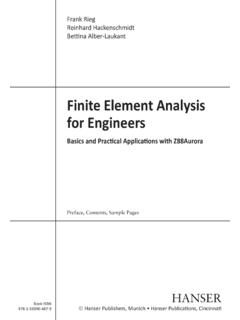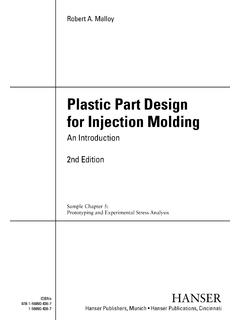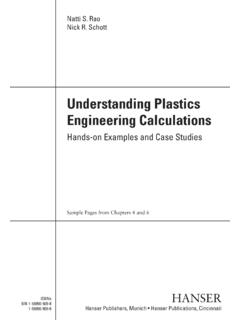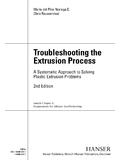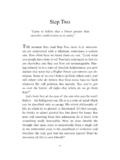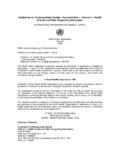Transcription of How to Improve Rubber Compounds (2nd Edition)
1 How to ImproveRubber Compounds1800 Experimental Ideas for Problem SolvingJohn S. DickBook ISBN978-1-56990-533-3 HANSER Hanser Publishers, Munich Hanser Publica ons, Cincinna Sample PagesFor further informa on or to order, : Rubber Technology, Compounding and Testing for Performance. 2nd ed. Edited by J. S. Dick, Hanser Publications, 2009 GEN: General References from the Literature RP: Review Panel (Advisors for this book) IMPORTANT: The information contained herein is experimental in nature and is meant for individuals with advanced scientific training and Rubber compounding experience. All safety precautions should be taken when replicating or applying this information.
2 The author makes no representation or warranty, either expressed or Improving Degradation Resistance of Cured Rubber Compounds Improving Hot Air and/or Heat Aging ResistanceHot air aging and heat aging resistance are becoming very important today, espe-cially in automotive applications where under-the-hood operating temperatures have been increasing and there is more pressure from automotive manufacturers to have Rubber parts that last longer (part of the move toward a 150,000-mile car warranty!). Anaerobic heat aging resistance can be quite different from hot air aging resistance. For example, a Rubber compound might possess good reversion resistance (anaerobic), yet still be subject to oxidative attack (or vice versa).
3 The type of aging properties that a cured Rubber compound possesses is very important in determining how that compound will be classified in accordance with SAE J200/ASTM D2000 for automotive following experimental ideas might Improve a Rubber compound s hot air aging resistance and/or heat aging resistance (but not always both). Also, all relevant literature sources, including the ones cited below, should be researched and read. Caution: these general experimental ideas may not work in all specific situations. Changes to Improve hot air aging or heat aging resistance will certainly affect other properties as well, for better or for worse, and this book does not purport to show how these other properties are affected.
4 Also, this book does not purport to address safety and health issues. Subjective Ranking of Rubber One overall subjective ranking that can be applied to different base elastomers for heat resistance is as follows:FKM (Best) > VMQ > Fluorosilicone > ACM > AEM > EPDM > CO/ECO CM > CSM NBR > CR > IIR NBR/PVC > SBR > NR1263 Improving Degradation Resistance of Cured Rubber CompoundsRT: Rubber Technology, Compounding and Testing for Performance. 2nd ed. Edited by J. S. Dick, Hanser Publications, 2009 GEN: General References from the Literature RP: Review Panel (Advisors for this book) IMPORTANT: The information contained herein is experimental in nature and is meant for individuals with advanced scientific training and Rubber compounding experience.
5 All safety precautions should be taken when replicating or applying this information. The author makes no representation or warranty, either expressed or : J. Horvath, Selection of Polymers for Automotive Hose and Tubing Appli-cations, Rubber World, December 1987, p. subjective ranking that can be applied to base elastomers for heat resistance is the following:FKM (Best) TFE > VMQ/PVMQ/MQ > FVMQ > AEM > EPM > EPDM ACM > CSM > CR > NR NBR > AU/EU > SBR/BRGEN: R. Mastromatteo, E. Morrisey, M. Mastromatteo, H. Day, Matching Material Properties to Application Requirements, Rubber World, February, 1983, p. so-called continuous use temperature rankings for specialty elastomers were reported as follows:Type of rubberContinuous use temperatureHNBR145 C (293 F)ACM150 C (302 F)AEM160 C (320 F)AG (DAI-EL Alloy AG-1530)175 C (347 F)FKM230 C (446 F)GEN: M.
6 Kishine, T. Noguchi, New Heat-Resistance Elastomers, Rubber World, February, 1999, p. 40. Perfluoroelastomers Often perfluoroelastomers (FFKMs) are selected as the base Rubber for a compound when the ultimate heat resistance is needed. FFKM polymers report-edly can impart useful service life at temperatures as high as 316 C (601 F). GEN: M. Coughlin, R. Schnell, S. Wang, Perfluoroelastomers in Severe Envi-ronments: Properties, Chemistry, and Applications, Presented at ACS Rubber Div. Meeting, Spring, 2001, Paper No. 24. Fluoroelastomers Compounds based on FKM possess extremely good heat aging resistance. RT: Chapter 6, Elastomer Selection, R.
7 School, p. (FKM) Compounds can achieve heat resistance up to 260 C (500 F). GEN: M. Chase, Roll Coverings Past, Present, and Future, Presented at Rubber Roller Group Meeting, New Orleans, May 15 17, 1996, p. maximize compound high-temperature performance, the best acceptor for the chosen FKM must be selected. Common types of acceptors for FKM Compounds are low-activity magnesium oxide, high-activity magnesium oxide, calcium Improving Hot Air and/or Heat Aging ResistanceRT: Rubber Technology, Compounding and Testing for Performance. 2nd ed. Edited by J. S. Dick, Hanser Publications, 2009 GEN: General References from the Literature RP: Review Panel (Advisors for this book) IMPORTANT: The information contained herein is experimental in nature and is meant for individuals with advanced scientific training and Rubber compounding experience.
8 All safety precautions should be taken when replicating or applying this information. The author makes no representation or warranty, either expressed or , calcium hydroxide, zinc oxide, and lead oxide (litharge), which is toxic. RT: Chapter 6, Elastomer Selection, R. School, p. Compounds provide extremely good protection against air aging and can provide a useful service life at temperatures greater than 200 C (392 F). RT: Chapter 8, Specialty Elastomers, R. Stevens, p. even better heat aging resistance of a fluoroelastomer compound, select a bisphenol AF cure system. RT: Chapter 8, Specialty Elastomers, R. Stevens, p. fluoroelastomers made with vinylidene fluoride, tetrafluoroethylene, and propylene reportedly possess better aging properties for many aggressive engine oils at high temperatures compared to conventional FKM elastomers.
9 This is reported to be attributable to the use of propylene in place of hexafluoro-propylene in the polymerization process. GEN: W. Grootaert, R. Kolb, A. Worm, A Novel Fluorocarbon Elastomer for High-Temperature Sealing Applications in Aggressive Motor-Oil Environments, Rubber Chemistry and Technology, September October, 1990, Vol. 63, p. following is a general ordinal ranking of different types of fluoroelastomers in regards to the heat resistance they impart to a Rubber compound:FFKM ( 72% F) Best > FKM Type 2 ( 70% F) > FKM Type 1 ( 65% F)GEN: Jim Denham (3M), Basic Fluoroelastomer Technology, Presented at the Energy Rubber Group, September 13, 2011, Galveston, severe conditions of very high pressure and very high temperature (HPHT) in down-hole oil drilling operations using fluoroelastomer Compounds , to help avoid explosive decompression (ED) as a mode of failure, consider using the new ultra-high-viscosity (UHV) fluoroelastomers [ML (1 + 10 @ 121 C) = 150], 66% fluorine content, bisphenol AF curable.
10 GEN: J. Denham (Dyneon 3M), Solutions for the Oil and Gas Industry, Presented at the Spring Meeting of the Energy Rubber Group, May 28, 2009, Arlington, TX. HNBR Compounds based on HNBR possess very good heat aging resistance. The higher the level of hydrogenation is, the better the heat aging will be because there are fewer unsaturated sites on the polymer backbone that can be attacked. RT: Chapter 8, Specialty Elastomers, M. Wood, p. grades of HNBR can be sulfur cured because they still possess some unsaturation. However, an HNBR compound will usually possess better heat aging resistance if it is cured with peroxide instead of sulfur.



